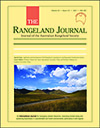Professor Xiaoni Liu (Gansu Agricultural University, China)
Professor Huilong Lin (Lanzhou University, China)

The Rangeland Journal
Volume 43 Numbers 5 & 6 2021
Special IssueApplication and development of the Rangeland Comprehensive and Sequential Classification System
Rangelands are some of the most widely distributed ecosystems on Earth, covering ~20% of the land surface area. As an important part of terrestrial ecosystems, accurate rangeland classification plays a crucial role in carbon cycling, biodiversity conservation and forage production. The Comprehensive Sequential Classification System of Rangeland (CSCSR), a well accepted rangeland classification system, has attracted global attention and has undergone further development. This paper reviews the origin and development of the CSCSR and its application in the fields of climate change, rangeland and livestock productions, even rangeland ecosystem services in detail.
The discovery of grassland field, form and biomass in China is a fundamental problem of grassland sustainable development. Based on systematic sampling, the original classic model and the current classification indices-based model have been updated by evaluating and checking the Normalised Difference Vegetation Index to evaluate the best model appropriate for the conditions. The spatial patterns of grasslands based on net primary productivity provide a basis for sustainable use of grassland resources and management strategies for grassland classification.
Kobresia meadow in the Three-River Headwaters region is fragile and sensitive to climate change. In this study, the responses of Kobresia meadow’s suitable distribution to the ecological conservation policy and climate change were predicted for the first time using the MaxEnt model in combination with geographic information systems. The results will contribute crucially to the policy-making of conservation and the sustainable development of livestock husbandry in this region.
Potential natural vegetation plays a key role in ecological reconstruction, as well as development of agriculture and livestock production. In this study, the historical, current and future meteorological data in conjunction with Comprehensive and Sequential Classification System were applied to classify global PNV. Furthermore, the spatio-temporal patterns, and successional processes of global PNV as well as the response to climate changes were analysed. The results can be taken as a reference for ecological reconstruction and revegetation of degraded ecosystems.
This study discusses spatial patterns of land use during the Holocene Megathermal in China. Archaeological materials showed that foxtail millet, broom millet and rice were the main crops sown; their distribution reflecting the pattern of land use. Combining proxy-based ancient temperature and precipitation data with modern climate data, average annual accumulated temperature of ≥10°C in the Holocene Megathermal was determined, and spatial pattern of land use was interpolated. This was validated using archaeological data from 141 agricultural heritage sites.
Assessing current and future potential grassland vegetation types and distribution has important practical implications in grassland management. In our study, historical and projected climate data were used to classify grassland classes for two historical periods (1960–1986 and 1986–2011) and for two future periods (2021–2040 and 2041–2060) using the Comprehensive and Sequential Classification System (CSCS), and the changes of grassland classes in these time periods were investigated. Insights obtained from this study will improve our understanding of how grassland vegetation responds to climate change, and to facilitate the sustainable grassland management.
Understanding the response of net primary productivity (NPP) to future climate change is crucial for protecting grassland ecosystem’s security and implementing grassland classification management. We simulated China’s grassland NPP by meteorological data and remote sensing data and compared the current and future results. This research has demonstrated that China’s grassland NPP will increase under all future scenarios, but there are obvious spatial discrepancies among different grassland groups.
Results suggested that SRPV presented a pattern of total dispersion and partial agglomeration under all scenarios. The agglomerate regions spread from north-eastern China to south-western China. From the 2030s to the 2080s, SRPV exhibited characteristics of expansion and migration to the north under RCP scenarios. With increased radiation emission intensity, the distributed area of SRPV increased. These results both further expand the research on potential vegetation using the CSCS, and also provide guidance for rational utilisation and scientific management of regional natural vegetation resources.
Grassland resources in China have diverse categories and span extensive areas. But there are few reports on the potential loss of grassland ecosystem services in China. This study separately estimated the ecosystem service valves (ESVs) of Chinese potential grassland ecosystems and existing grassland ecosystems and calculated the loss of ESVs between the two grassland classification systems. The results can be taken as a reference for ecological reconstruction and revegetation of degraded ecosystem, and promotion for agriculture and animal husbandry.
China’s food security is a major issue related to all mankind. China’s agricultural structure urgently needs to be adjusted to adapt to the changing food consumption needs of residents. This paper analysed the dynamic changes in food consumption and developed grassland agriculture in different regions from the perspective of supply-side structural reform to meet the new demands of individuals’ food consumption. The article clarifies the new direction of China’s agricultural development and provides new solutions for solving food security problems.